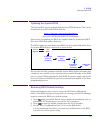
91
5
HP BIOS
The Setup program and BIOS are summarized in the two sections of this
chapter. The POST routines are described in the next chapter.
The BIOS is based on an AMIBIOS
®
core, which includes support for
4 M/bits flash parts, PCI 2.2 Specification, and RIMM or DIMM memory
modules. Added to this, a New BIOS Architecture (NBA) has been
implemented. The main principle of the NBA is that HP features are
independent modules and run at defined moments in the boot process. They
are installed as hooks, either in:
• Source code form, for small tasks, or before memory is available.
• Binary. As .COM files, for larger tasks once memory is available.
They both communicate with the BIOS through CMOS and memory tables
providing information to the operating system through SMBIOS tables.
So, what are hooks? Hooks are architected points in the BIOS where specific
code can be run. HP code is integrated, as mentioned above, in either
source/object files, or as separate binaries.
HP/NBA BIOS Summary
The System ROM contains the POST (Power-On-Self-Test) routines and the
BIOS: the System BIOS, video BIOS, and low option ROM. This chapter,
together with the following one, give an overview of the following aspects:
• Menu-driven Setup with context-sensitive help, described next in this
chapter.
• The address space, with details of the interrupts used, described at the
end of this chapter.
• The Power-On-Self-Test or POST, which is the sequence of tests the
computer performs to ensure that the system is functioning correctly,
described in the next chapter.
The system BIOS is identified by the version number qXX.YM.mm, where:
• q is an optional letter indicating non-production status (removed at
release).
• XX is a two-letter code indicating the system (IA).
• Y is a one-digit code indicating the HP entity.
• M is the major BIOS version.
• mm is the minor BIOS version.


















